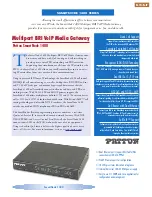
P-660HW-Tx v2 Series Support Notes
4. Where can you find 802.11 wireless networks?
Airports, hotels, and even coffee shops like Starbucks are deploying 802.11
networks so people can wirelessly browse the Internet with their laptops. As
these types of networks increase, this will create additional security risk for the
remote user if not properly protected.
5. What is an Access Point?
The AP (access point also known as a base station) is the wireless server that
with an antenna and a wired Ethernet connection that broadcasts information
using radio signals. AP typically acts as a bridge for the clients. It can pass
information to wireless LAN cards that have been installed in computers or
laptops allowing those computers to connect to the campus network and the
Internet without wires.
6. What is IEEE 802.11?
The IEEE 802.11 is a wireless LAN industry standard, and the objective of
IEEE 802.11 is to make sure that different manufactures' wireless LAN devices
can communicate to each other.802.11 provides 1 or 2 Mbps transmission in
the 2.4 GHz ISM band using either FHSS or DSSS.
7. What is 802.11b?
802.11b is the first revision of 802.11 standard allowing data rates up to
11Mbps in the 2.4GHz ISM band. Also known as 802.11 High-Rate and Wi-Fi.
802.11b only uses DSSS, the maximum speed of 11Mbps has fallbacks to 5.5,
2 and 1Mbps.
8. How fast is 802.11b?
The IEEE 802.11b standard has a nominal speed of 11 megabits per second
(Mbps). However, depending on signal quality and how many other people are
using the wireless ethernet through a particular Access Point, usable speed
will be much less (on the order of 4 or 5 Mbps, which is still substantially faster
than most dialup, cable and DSL modems).
9. What is 802.11a?
802.11a the second revision of 802.11 that operates in the unlicensed 5 GHz
band and allows transmission rates of up to 54Mbps. 802.11a uses OFDM
(orthogonal frequency division multiplexing) as opposed to FHSS or DSSS.
Higher data rates are possible by combining channels. Due to higher
frequency, range is less than lower frequency systems (i.e., 802.11b and
802.11g) and can increase the cost of the overall solution because a greater
number of access points may be required. 802.11a is not directly compatible
with 802.11b or 802.11g networks. In other words, a user equipped with an
802.11b or 802.11g radio card will not be able to interface directly to an
802.11a access point. Multi-mode NICs will solve this problem.
30
All contents copyright © 2006 ZyXEL Communications Corporation.
















































